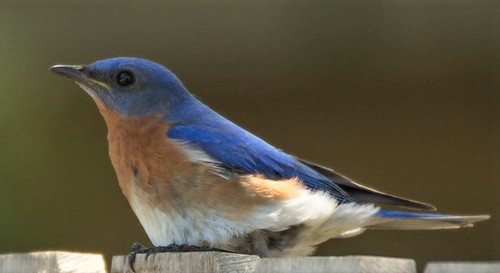Eastern Bluebird Bermuda
You will often see the bluebirds of Bermuda flocking together during winter. But between March to August they usually pair up for breeding. The eastern bluebirds, particularly the males have vivid blue plumage and look beautiful. The Latin name of the eastern bluebird is Sialia sialis. They are native to Bermuda.
Bermuda is the only place outside of North America where they are known to breed naturally. Their population density in Bermuda is much higher than in the US.
Although they normally make use of the holes in Cedar trees or cliffs for making nests, in the recent time they have become completely dependent on the artificial nest boxes provided at several places in the island. This is because of house sparrows which are their main competitors.
The aggressive sparrows have taken over most of the holes in rocks and trees. Plus the mass scale destruction of cedars in 1940s and 1950s led to such situation.
Eastern Bluebird Bermuda
Photo: Dolan, flickr, cc by 2.0
Sparrows also do not spare the artificial nest boxes. As a result the Bluebirds are able to breed and hatch during the wintertime when the hatching season for the sparrows are over. In the normal circumstances a bluebird otherwise breeds two to three times a year between March and August.
The male bird usually chooses the nest and the female makes the nest from dry grasses or casuarina leaves. The female lays 3-4 eggs over few days. After hatching the baby birds become ready for flying within three weeks. However, during their young age they have real threats from the house sparrows and
Kiskadees who try to kill them.
In a recent report it was stated that even the Warwick lizards are entering the nests and trying to eat up the eggs of the blue birds. Rats and cats are also part of their natural threats.
The eastern bluebirds as you see in the picture above are small in overall size. They have a round head, short legs and tail, long wings and a short bill. Their eyes are quite large. They feed on small insects on ground by dropping on them. During fall and winter, they also feed on berries.
You can find the bluebirds all over the island particularly in the open green like in
Golf Courses of Bermuda, and also see them perching on wires and low branches of scattered trees. They prefer undeveloped areas. Eastern bluebirds of Bermuda are protected by law. Many of their artificial nest boxes are located in the
nature reserves and national parks and golf courses across the island. There are over 500 individual bluebirds in Bermuda.
|
 By Raj Bhattacharya By Raj Bhattacharya
Raj, a seasoned travel writer and Bermuda destination expert, has extensive global travel experience. This website reflects his profound insights, garnered over nearly two decades of dedicated findings and research on the island. Raj has assisted countless Bermuda-bound visitors by providing direct, personalized responses to their queries and imparting his wealth of knowledge through this platform. This site serves as an indispensable guide for those seeking informed and reliable insights into Bermuda's treasures.
|
Related Articles
1. Check out
Bermuda Birds to know about all the birds in Bermuda and the best bird watching locations in the island.
|
Visitors' Reviews and Comments
Review and share your experience.
|

 By Raj Bhattacharya
By Raj Bhattacharya